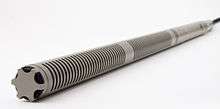Audio-Technica
Audio-Technica Corporation (株式会社オーディオテクニカ, Kabushiki Kaisha Ōdio Tekunika) is a Japanese company that designs and manufactures professional microphones, headphones, turntables, phonographic magnetic cartridges, and other audio equipment.
 Audio-Technica headquarters in Tokyo | |
| Private KK | |
| Industry | Audio equipment |
| Founded | 1962 Shinjuku, Tokyo |
| Founder | Hideo Matsushita |
| Headquarters | , Japan |
Key people | Kazuo Matsushita (President) |
| Products | |
| Website | audio-technica |
Company history

Audio-Technica was established in 1962 in Shinjuku, Tokyo, Japan, by Hideo Matsushita as a phonograph cartridge manufacturer. Its first products were the AT-1 and the AT-3 MM stereo phono cartridges. Business rapidly developed and Audio-Technica expanded into other fields. The headquarters and factory moved in 1965 to the current address in Naruse, Machida, Tokyo.[1] In 1969, the company began exporting phono cartridges worldwide and launched the first microcassette recorders.[2]
In 1972, Audio-Technica established its US arm in Fairlawn, Ohio, and started shipping VM phono cartridges to European manufacturers. In 1974, the company developed its first headphones, the AT-700 series, launched the same year. The AT-800 series of microphones were introduced in 1978 and in the same year the UK establishment in Leeds began operation.[1]
In 1986, the company developed RCA cables with "pure copper" produced with the continuous metal casting process (PCOCC), invented and developed between 1982 and 1985 by Atsumi Ohno.[3] In the same year, the company launched the AT33ML/OCC phono cartridge, the first made with PCOCC materials. In 1988, another Audio-Technica subsidiary is founded in Taiwan.[1]
In 1990s, Audio-Technica introduced several large-diaphragm condenser microphones for studio use: the AT4033 cardioid microphone in 1991,[1] the AT4050 multi-pattern in 1995,[4] and the AT4060 vacuum tube cardioid microphone in 1998;[5] the AT895, a DSP-controlled five-element microphone array providing adaptive directional audio acquisition, was introduced in 1999.[1] In 1996, the Southeast Asian establishment began operation in Singapore.[1]
In 2008, the company celebrated the 20th anniversary of supplying microphones for US Presidential Debates. For their 50th anniversary, Audio-Technica celebrated at Consumer Electronics Show 2012, debuting their AT-LP1240-USB USB DJ Turntable[6] and ATH-CKS55i.[7]
In 2017, Audio-Technica Pure Digital Drive Wireless Headphone ATH-DSR9BT received CES Innovation Honoree Awards[8] by using Trigence Dnote Technology.[9]
Audio equipment supplier
Since the late 1990s, Audio-Technica supplied microphones and headphones for US television shows such as the Big Brother, Deal or No Deal, the Rock and Roll Hall of Fame inductions and several international events:
| Period | Event | Editions |
|---|---|---|
| 1996–present | Summer Olympic Games | Atlanta 1996, Sydney 2000, Athens 2004, Beijing 2008, London 2012[10] |
| 2002–present | Winter Olympic Games | Salt Lake City 2002, Torino 2006, Vancouver 2010, Sochi 2014, Pyeongchang 2018[10] |
| 1998–2013 | Grammy Awards | 1998–2013[11] |
| 2019 | MotoGP | 2019[12] |
Technology


One of their most famous products was a battery-operated, portable record player called Mister Disc that was sold in the U.S. in the early 1980s.
In 2005, Audio-Technica developed "Uniguard", a method for making microphones resistant to radio frequency interference from cell phones, Bluetooth devices, wireless computer networks and walkie-talkies. 13 patents were involved in bringing the feature to fruition, as company engineers modified many different elements of microphone construction and operation. Over 50 existing Audio-Technica microphone models have been upgraded with the new RFI-resistant technology.[13][14][15]
Notable products

- Audio-Technica AT770 (Mister Disc) - a portable vinyl record player
- Audio-Technica AT2020 - a medium-diaphragm cardioid condenser microphone
- Audio-Technica ATH-WS55 - over-ear consumer Solid Bass headphones
- Audio-Technica ATH-WS99BT - over-ear consumer Solid Bass headphones (53 mm drivers, Bluetooth 3, Class 2)
- Audio-Technica ATH-M50 - over-ear professional studio monitor headphones
- Audio-Technica ATH-M50x - over-ear professional studio monitor headphones (Successor to the ATH-M50)
- Audio-Technica ATH-MSR7 - over-ear headphones
- Audio-Technica ATH-SR5BT - On-Ear Wireless High-Resolution Audio Headphones
- Air Dynamic Series - circumaural audiophile open air headphones
- Audio-Technica ATH-AD500 - 40 mm drivers
- Audio-Technica ATH-AD700 - 53 mm drivers, angled
- Audio-Technica ATH-AD900 - 53 mm drivers, reduced bass roll off
- Audio-Technica ATH-R70x - 45 mm drivers
- Audio-Technica ATH-CKS55 - Consumer Solid Bass in-ear buds
- Audio-Technica AT-LP120-USB - mid-range turntable
- Audio-Technica AT-LP1240-USB - USB DJ Turntable
- Audio-Technica AT-95e - Turntable cartridge for Hi-Fi setups
- Audio-Technica AT11E - Turntable cartridge for Hi-Fi setups
- Audio-Technica ATH-DSR9BT - Pure Digital Drive Wireless Headphones
References
- "About Us". Audio-Technica. Archived from the original on 3 November 2009. Retrieved 25 November 2009.
- "Audio-Technica". www.gearogs.com. Retrieved 3 March 2016.
- patent, Ohno, Atsumi, "Continuous metal casting", issued 1985-05-07
- "Audio-Technica AT4050 ST". www.soundonsound.com. Retrieved 3 December 2019.
- "Audio–Technica AT4060A". www.soundonsound.com. Retrieved 3 December 2019.
- Fenlon, Wesley (12 January 2012). "Article about Audio-Technica's 2012 CES presence". Tested.com. Retrieved 1 December 2013.
- "Audio Technica 2012 CES Press Release about ATH-CKS55i Headphones". Audio-technica.com. Retrieved 1 December 2013.
- "Audio-Technica's ATH-DSR9BT Pure Digital Drive Wireless Headphones and AT-ART1000 Direct Power System Phono Cartridge Win CES 2017 Innovation Honoree Awards". Retrieved 23 August 2017.
- "Dnote Technology, 'Pure Digital' Audio". Retrieved 23 August 2017.
- "About Audio-Technica". eu.audio-technica.com. Retrieved 3 December 2019.
- Business, AVNetwork Staff2013-02-13T00:00:00Z. "GRAMMY Awards Show Uses Audio-Technica Microphones". systemscontractor. Retrieved 3 December 2019.
- Sports, Dorna. "Audio-Technica: capturing the sound of MotoGP™". www.motogp.com. Retrieved 3 December 2019.
- "Sound & Video Contractor, January 1, 2006. John McJunkin. Audio-Technica UniPoint Line: New improvements to a solid and reliable line of microphones". Svconline.com. Archived from the original on 3 December 2013. Retrieved 1 December 2013.
- Audio Courses dot com. Audio-Technica Provides UniGuard RFI Protection for New Engineered Sound Integ Archived 7 September 2008 at the Wayback Machine
- "Audio Technica. Audio-Technica's UniGuard technology: Protection from Radio Frequency Interference". Audio-technica.com. Retrieved 1 December 2013.